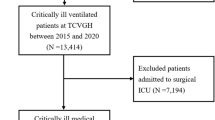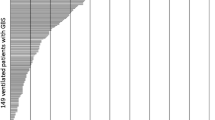Abstract
Background
Hyperglycemia has been found to be associated with higher risk of ICU-acquired weakness. However, the impact of hyperglycemia on the outcome of patients with respiratory failure from a primary neuromuscular condition is not known.
Methods
We reviewed 85 patients admitted to an ICU at Mayo Clinic (Rochester) with primary acute neuromuscular respiratory failure. Time of hyperglycemia (defined as >140 mg/dL and as >180 mg/dL) was calculated for each patient. Associations between hyperglycemic time, insulin administered, and outcome measures (duration of mechanical ventilation, in-hospital mortality, functional outcome at discharge, and at last follow-up) were evaluated using logistic regression analysis.
Results
Although longer hyperglycemic time was associated with longer mechanical ventilation time and poorer short-term outcome on univariate analyses, these associations were no longer present when the analysis was adjusted for length of ICU stay. On this adjusted analysis, there were no significant associations between hyperglycemic time and duration of mechanical ventilation, in-hospital mortality, or functional outcome at discharge or at follow-up either for the entire cohort or for relevant subgroups (diabetics, non-diabetics, patients with neuropathy). The amount of insulin administered did not influence the outcome measures. Neither hyperglycemia nor the amount of insulin during the first 7 days of ICU admission was associated with any of the outcome measures.
Conclusions
In our cohort, we did not find evidence that the duration of hyperglycemia or the amount of insulin given had any major impact on the outcomes of patients with primary acute neuromuscular respiratory failure.
Similar content being viewed by others
References
Serrano MC, Rabinstein AA. Causes and outcomes of acute neuromuscular respiratory failure. Arch Neurol. 2010;67:1089–94.
Serrano MC, Rabinstein AA. Usefulness of pulmonary function tests and blood gases in acute neuromuscular respiratory failure. Eur J Neurol. 2012;19(3):452–6.
Young MJ, Boulton AJM, Macleod AF. et al A multicentre study of the prevalence of diabetic peripheral neuropathy in the United Kingdom hospital clinic population. Diabetologia. 1993;36:150–4.
Thomas PK. Diabetic peripheral neuropathies: their cost to patient and society and the value of knowledge of risk factors for development of interventions. Eur Neurol. 1999;41(Suppl 1):35–43.
Diabetes Control and Complications Trial Research Group. The effect of intensive treatment of diabetes on the development and progression of long-term complications in insulin-dependent diabetes mellitus. N Engl J Med. 1993;329:977–86.
Dyck PJ, Giannini C. Pathologic alterations in the diabetic neuropathies of humans: a review. J Neuropathol Exp Neurol. 1996;55:1181–93.
Tomlinson DR, Gardiner NJ. Glucose neurotoxicity. Nat Rev Neurosci. 2008;9(1):36–45.
Stewart MA, Sherman WR, Anthony S. Free sugars in alloxan diabetic rat nerve. Biochem Biophys Res Commun. 1966;22(5):4–91.
Singer M, De Santis V, Vitale D, Jeffcoate W. Mutiorgan failure is an adaptive, endocrine-mediated, metabolic response to overwhelming systemic inflammation. Lancet. 2004;364:545–8.
Capes SE, Hunt D, Malmberg K. Stress hyperglycemia and prognosis of stroke in nondiabetic and diabetic patients: a systematic overview. Stroke. 2001;32(10):2426–32.
Gray CS, Hildreth AJ, Alberti GK, et al. Poststroke hyperglycemia: natural history and immediate management. Stroke. 2004;35(1):122–6.
Nanas S, Kritikos K, Angelopoulos E, et al. Predisposing factors for critical illness polymyoneuropathyin a multidisciplinary intensive care unit. Acta Neurol Scand. 2008;118:175–81.
Latronico N, Bolton CF. Critical illness polyneuropathy and myopathy: a major cause of muscle weakness and paralysis. Lancet Neurol. 2011;10:931–41.
Kress JP, Hall JB. ICU-acquired weakness and recovery from critical illness. N Engl J Med. 2014;370:1626–35.
Hermans G, De Jonghe B, Bruyninckx F, et al. Interventions for preventing critical illness polyneuropathy and critical illness myopathy. Cochrane Database Syst Rev. 2009;1:CD006832.
Hermans G, Wilmer A, Meersseman W, et al. Impact of intensive insulin therapy on neuromuscular complications and ventilator dependency in the medical intensive care unit. Am J Respir Crit Care Med. 2007;175:480–9.
Van den Berghe G, Schoonheydt K, Becx P, et al. Insulin therapy protects the central and peripheral nervous system of intensive care patients. Neurology. 2005;64:1348–53.
Eliasson SG. Nerve conduction changes in experimental diabetes. J Clin Invest. 1964;43:2353–8.
Kennedy JM, Zochodne DW. The regenerative deficit of peripheral nerves in experimental diabetes: its extent, timing and possible mechanisms. Brain. 2000;123:2118–29.
Bolton CF. Neuromuscular manifestations of critical illness. Muscle Nerve. 2005;32:140–63.
Krishnan AV, Kiernan MC. Altered nerve excitability properties in established diabetic neuropathy. Brain. 2005;128:1178–87.
Hermans G, Vanhorebeek I, Derde S, et al. Metabolic aspects of critical illness polyneuromyopathy. Crit Care Med. 2009;37:S391–7.
Langouche L, Vanhorebeek I, Vlasselaers D, et al. Intensive insulin therapy protects the endothelium of critically ill patients. J Clin Investig. 2005;115:2277–86.
NICE-SUGAR Study Investigators, Finfer S, Chittock, Su SY, Blair D, Foster D, Dhingra V, Bellomo R, Cook D, Dodek P, Henderson WR, Hébert PC, Heritier S, Heyland DK, McArthur C, McDonald E, Mitchell I, Myburgh JA, Norton R, Potter J, Robinson BG, Ronco JJ. Intensive versus conventional glucose control in critically ill patients. N Engl J Med. 2009;360(13):1283–97.
Rabinstein AA. Hyperglycemia in critical illness: lessons from NICE-SUGAR. Neurocrit Care. 2009;11:131–2.
Godoy DA, Di Napoli M, Rabinstein AA. Treating hyperglycemia in neurocritical patients: benefits and perils. Neurocrit Care. 2010;13:425–38.
Acknowledgments
MCS has been supported by the program Rio-Hortega (Spanish ISCIII).
Conflicts of interest
Macarena Cabrera, Jennifer Fugate, Jay Mandrekar, and Alejandro Rabinstein declare that they have no conflict of interest.
Author information
Authors and Affiliations
Corresponding author
Rights and permissions
About this article
Cite this article
Cabrera-Serrano, M., Fugate, J.E., Mandrekar, J. et al. Impact of Hyperglycemia in the Outcome of Patients with Primary Neuromuscular Respiratory Failure. Neurocrit Care 23, 103–107 (2015). https://doi.org/10.1007/s12028-015-0114-0
Published:
Issue Date:
DOI: https://doi.org/10.1007/s12028-015-0114-0




